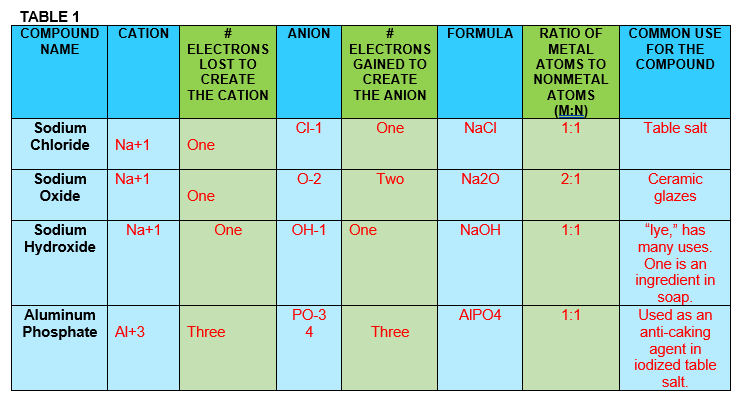To draw a Lewis Structure, start with the atomic symbol in the middle, then put dots around the symbol until all of the valence electrons are represented. Try to envision a box around the atom symbol, and the electrons on each side of the box. The valence electrons should be drawn around the element symbol one on each side before pairing the electrons up. The maximum number of electrons that could be on one side of a Lewis Structure is two, and the maximum number of electrons around an element symbol is eight. To figure out how many valence electrons each element has, use the Periodic Table. Remember, the number of valance electrons for Group A elements is equal to the Group A number the element is in on the Periodic Table. Use the data you collected in Table 1 to a draw Lewis structure model to show the formation of any one of the compounds you assembled, then explain the model you drew. Remember, you should be explaining and supporting your answers by referencing and citing the data collected from the table. Please do NOT use sodium chloride.
Formal Charges
Formal charges have an important role in organic chemistry since this concept helps us to know whether an atom in a molecule is neutral/bears a positive or negative charge. Even if some molecules are neutral, the atoms within that molecule need not be neutral atoms.
Polarity Of Water
In simple chemical terms, polarity refers to the separation of charges in a chemical species leading into formation of two polar ends which are positively charged end and negatively charged end. Polarity in any molecule occurs due to the differences in the electronegativities of the bonded atoms. Water, as we all know has two hydrogen atoms bonded to an oxygen atom. As oxygen is more electronegative than hydrogen thus, there exists polarity in the bonds which is why water is known as a polar solvent.
Valence Bond Theory Vbt
Valence bond theory (VBT) in simple terms explains how individual atomic orbitals with an unpaired electron each, come close to each other and overlap to form a molecular orbital giving a covalent bond. It gives a quantum mechanical approach to the formation of covalent bonds with the help of wavefunctions using attractive and repulsive energies when two atoms are brought from infinity to their internuclear distance.
To draw a Lewis Structure, start with the atomic symbol in the middle, then put dots around the symbol until all of the valence electrons are represented. Try to envision a box around the atom symbol, and the electrons on each side of the box. The valence electrons should be drawn around the element symbol one on each side before pairing the electrons up. The maximum number of electrons that could be on one side of a Lewis Structure is two, and the maximum number of electrons around an element symbol is eight.
To figure out how many valence electrons each element has, use the Periodic Table. Remember, the number of valance electrons for Group A elements is equal to the Group A number the element is in on the Periodic Table.
Use the data you collected in Table 1 to a draw Lewis structure model to show the formation of any one of the compounds you assembled, then explain the model you drew. Remember, you should be explaining and supporting your answers by referencing and citing the data collected from the table. Please do NOT use sodium chloride.


Trending now
This is a popular solution!
Step by step
Solved in 5 steps with 4 images









